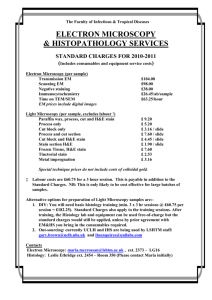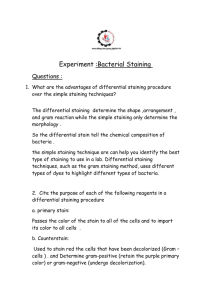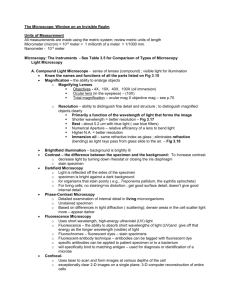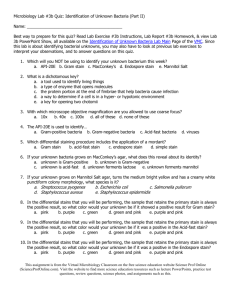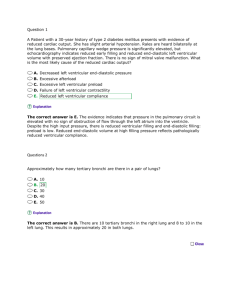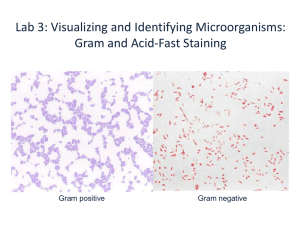PowerPoint file
advertisement
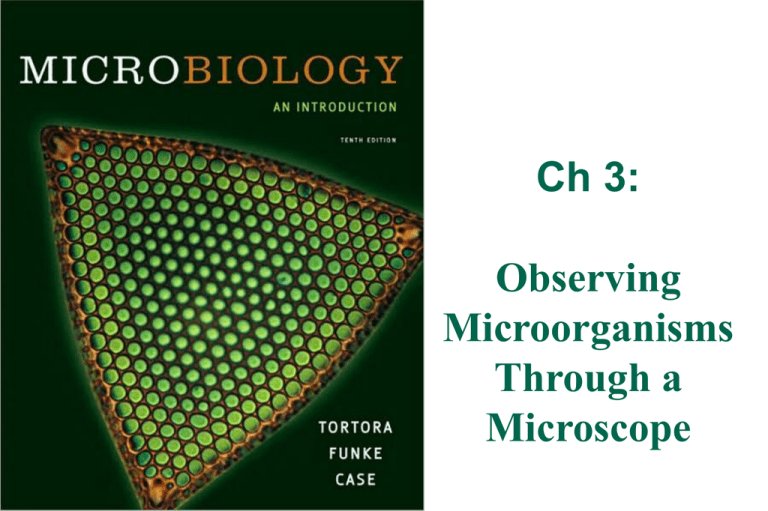
Ch 3: Observing Microorganisms Through a Microscope Q&A Acid-fast staining of a patient’s sputum is a rapid, reliable, and inexpensive method to diagnose tuberculosis. What color would bacterial cells appear if the patient has tuberculosis? Objectives Review the metric units of measurement Define total magnification and resolution Explain how electron and light microscopy differ Differentiate between acidic and basic dyes Compare simple, differential, and special stains List the steps in preparing a Gram stain. Describe the appearance of Gram-positive and Gram-negative cells after each step Compare and contrast Gram stain and acid-fast stain Explain why endospore and capsule stains are used Units of Measurement Review Table 3.1 • 1 µm = ______ m = ______ mm • 1 nm = ______ m = ______ mm • 1000 nm = ______ µm • 0.001 µm = ______ nm Sizes Among Microorganisms • Protozoa: 100 µm • Yeasts: 8 µm Cells Alive – How big is a . . .? • Bacteria: 1 - 5 µm (some much longer than wide) • Rickettsia: 0.4 µm = _________ nm • Chlamydia and Mycoplasma: 0.25 µm • Viruses: 20 – 250 nm Principles of the Compound Light Microscope Magnification: Ocular and objective lenses of compound microscope (total mag.?) Resolution: Ability of lens to . . . Maximum resolving power ___ m Contrast: Stains change refractive index contrast between bacteria and surrounding medium Fig 3.1 Refractive Index • Measures light-bending ability of a medium • Light may bend in air so much that it misses the small high-magnification lens. • Immersion oil is used to keep light from bending. Fig 3.3 Microscopy: The Instruments Brightfield Microscopy • Simplest of all the optical microscopy illumination. techniques • Dark objects are visible against a bright background. Darkfield Microscopy • Light objects visible against dark background. • used to enhance the contrast in unstained samples. • Instrument of choice for spirochetes Spirochetes (Treponema pallidum) viewed with darkfield microscope Fluorescence Microscopy • Uses UV light. • Fluorescent substances absorb UV light and emit visible light. • Cells may be stained with fluorescent chemicals (fluorochromes). • Immunofluorescence Fig 3.6; T. pallidum Figure 3.6a Fig 3.6b Principle of Immunofluorescence Electron Microscopy: Detailed Images of Cell Parts Uses electrons, electromagnetic lenses, and fluorescent screens Electron wavelength ~ 100,000 x smaller than visible light wavelength Specimens may be stained with heavy metal salts Two types of EMs:? SEM or TEM? Bacterial division Leaf surface ? 10,000-100,000; resolution 2.5 nm. Rod-shaped Mycobacterium avium Preparation of Specimens for Light Microscopy • Staining Techniques Provide Contrast • Smear air-dry heat-fix • Basic dyes: cationic chromophore • Acidic dyes: anionic chromophore negative staining (good for capsules) • Three types of staining techniques: Simple, differential, and special Simple Stains • Use a single basic dye. • A mordant may be used to hold the stain or coat the specimen to enlarge it. Differential Stains React differently with different bacteria • Gram stain • Acid fast stain Review of different staining techniques Important Staining Reactions in Microbiology For Gram stain technique compare to Fig 3-12 Gram Stain crystal violet safranin Acid Fast Stain • Cells that retain a basic stain in the presence of acid-alcohol are called acid-fast. • Non–acid-fast cells lose the primary stain when rinsed with acid-alcohol, and are counterstained with a different color basic stain Special Stains See Fig 3.14 • Endospore stain: Heat is required to drive a stain into the endospore. • Flagella staining: requires a mordant to make the flagella wide enough to see. • Capsule stain uses basic stain and negative stain
